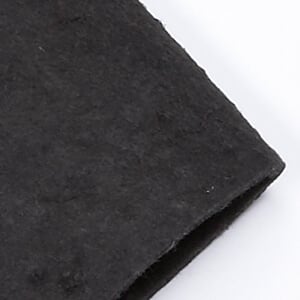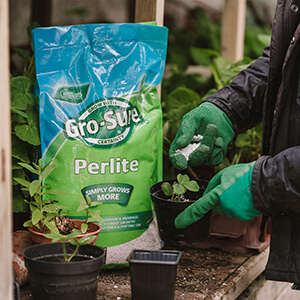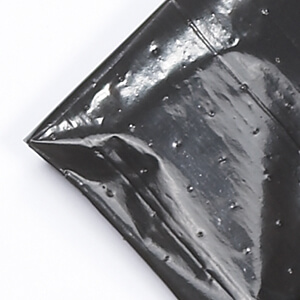Save time and effort watering, as well as improving plant growth by using water matting on your benches and shelves in your greenhouse or polytunnel.
A sponge-like material, water matting has been developed to have high water retention, with the air pockets between fibres naturally holding water droplets.
Our water matting can hold up to 12 pints of water per square yard.
Using water matting provides you and your plants with lots of advantages, which we have outlined below:
Cost Effective
Although we supply water mats pre cut to specific sizes, you can also purchase water matting per metre, allowing you to cut it to size to suit your benching, trays, or pots.
|
Water Matting Per Metre Available in a range of different widths simply purchase as many metres as you require. You can then easily cut it to suit your growing space using a pair of scissors or sharp knife. Click here to see full details. |
This means that for those thrifty gardeners who like to save money you can purchase the matting to cut to suit your existing trays or pots – you don’t have to stick to pre-cut sizes – and can create tailor-made mats to suit your space.
Saves Time
Once your water matting is in place below your seed trays and plant pots, you can water the matting rather than the plants or their containers – so just one place to water rather than many. Or you could set up a drip system, setting the nozzles to drip water onto the matting, then you won’t even need to spend the time using a watering can, to apply the water to the matting.
Before using the matting for the first time, water your plants as normal from the top of the seed trays or pots – if the compost is completely dry then capillary action will not take place.
The plastic pots and trays which work with water matting need to have holes in their bases (rather than their sides) that can fit flush to the surface of the matting. When using the matting for the first time, simply push the trays and pots down firmly so that the drainage holes are right up against the matting so that capillary action can take place.
Traditional clay pots will also work well with water matting as they are good at absorbing moisture – you just need to you ensure that the pots are well watered before placing them on the matting for the first time.
Top Tip
Watering below using water matting is better for those plants which might be adversely affected by watering from above – this includes plants whose leaves or fruit might be blemished by water droplets, or those which are sensitive to crown rot.
How It works
Once your matting has been watered, as the compost within your seed trays or pots starts to dry, water will rise from the matting by capillary action (also sometimes called ‘wicking’), keeping the compost moist. In this way your plants will be evenly watered throughout the day and it will also prevent overwatering, as the matting will also draw excess moisture from the compost in the seed trays and pots on it.
Top Tip
As water is being applied to the matting and then absorbed slowly into the compost in the pots or seed trays, rather than directly onto the plant or into the pot, then the water will be at room temperature rather than being a ‘shock’ of cold water to your plants.
Water at either extreme – either cold or hot – can damage plant growth – you’ll find most species will respond better with water at room temperature (ideally approx. 20*C / 68*F). Although there are always exceptions to the rule – orchid growers have found that one species particularly likes temperature fluctuations, and that these fluctuations actually spurs on new flower growth.
It should be noted, that if you have plants growing in pots with a ‘drainage layer’ in their base (such as pieces of broken pot or gravel) then these plants will not be able to access the water from the water matting as the capillary action won’t work.
Tests by commercial growers have also shown that having a mix of 75% compost and 25% of an aerating component, for example perlite, will make this type of watering system even more efficient.
Top Tip
As your water matting is below your plants for a long period of time, as they grow their roots could easily grow into the matting making them difficult to move when its time for them to be potted on or moved out into your garden. To prevent this, simply turn the seed trays every week to stop the roots from taking hold.
Easy To Clean
As water matting can be used successfully for several growing seasons, we recommend that it is cleaned between seasons to keep it working efficiently. Washing will remove any excess soil which has fallen onto it and will clear any algae which may have started to grow. It’s best to wash it by hand, in either clean water or with a natural disinfectant added, such as Citrox.
|
Citrox Disinfectant Ideally thoroughly drench the matting or sand beds with this dilute solution once a month throughout the year – increase to up to once a week when temperatures are high. Click here to see full details. |
Top Tip
You can help to keep the surface of your water matting cleaner and algae free by covering the matting with a layer of perforated polythene. This thin black plastic is covered in small perforations to allow the water through whilst preventing overspill of compost from soiling the matting. Any algae that might grow would form on this polythene surface so will be quick and easy to wipe away. Using this polythene would also prevent plant roots from working their way into the water matting, so helping to extend the life of the water matting.
Did You Know ?
There are some plants that would not like to be watered in this way – namely those which prefer their soil to dry out between watering rather than their soil staying moist – this includes cacti and succulents.





